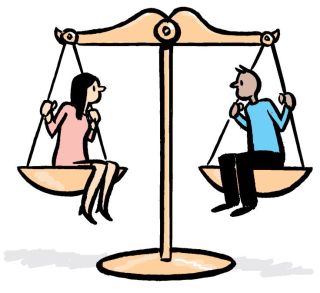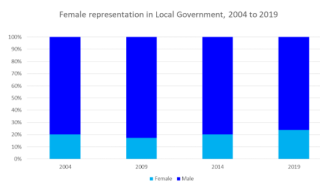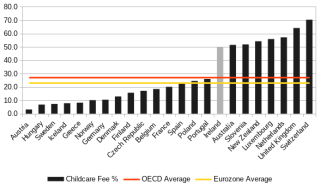Female Representation in Politics in Ireland

Women are significantly out-numbered by men in politics in Ireland. Gender quota legislation introduced prior to the 2016 General Elections resulted in a 6.5 percentage point increase in those elections from 15.7 per cent of seats held by women to 22.2 per cent. As this same gender quota legislation did not apply to the 2019 Local Elections, the increase in the number of women elected increased from 20.1 per cent to 23.9 per cent, a rise of just 3.8 percentage points.
Local Government
Between 2004 and 2019, there were about four times as many men as women in Local Government seats with very little change over that period. 20.2 per cent of Local Government seats were taken by women in 2004, decreasing to 17.3 per cent in 2009 and then increasing to 20.1 per cent in 2014 and then 23.9 per cent in 2019 (see Chart 1). Dublin has the largest proportion of seats held by women, 38.8 per cent in 2019. In the 2004 elections, the Midlands returned the lowest proportion, only 11.1 per cent of seats to female candidates. This changed to the South East region in 2019, as they returned the lowest proportion, only 13 per cent of seats were held by women candidates.
Overall improvements have been noted between the 2004 and 2019 Local Elections, especially in counties that had a low number of women candidates in 2004. In that year, there were nine Local Authorities who had less then 10 per cent of their seats filled by women, in 2019, there were three. Clare increased the number of seats held by women from just 6.3 per cent in 2004 to 14.3 in 2019. Likewise in Laois, the proportion there increased from 8 per cent to 26.3 per cent in the same period. The Local Government Reform Act of 2014 had an impact when Waterford City, who had 13.3 per cent of seats held by women, merged with Waterford County, who has 21.7 per cent of their seats held by women. By 2019, the merged Waterford City and County only had 6.3 per cent female representation.
In 2019, 50 per cent, exactly half the seats in Dún Laoghaire-Rathdown were taken by women. This was the highest proportion in the country with the lowest that year in Longford, returning only 5.6 per cent. Only Fingal had more than 40 per cent of the seats held by women in 2004. By 2019, they were joined by Dublin City, Kildare and Dún Laoghaire-Rathdown.
Chart 1. Female Representation in Local Government, 2004 to 2019. [1]

National Government
The 2011 General Election, only 15.7 per cent of seats were held by women. Legislation then enacted prior to the 2016 General Election, which required political parties to ensure that at least 30 per cent of their candidates were women (and also that at least 30 per cent were men). Official party funding could be halved if this condition was not met. As a result, 22.2 per cents of seats in the 2016 General Election went to women. There was a wide variation though across the country. In the 2011 election, women TDs accounted for 25.5 per cent of Dublin seats and only 5.9 per cent of seats in both the West and Mid-West. In 2016, the gap was even wider. Dublin returned 40.9 per cent women compared to just 4.3 per cent in the South West.
Barriers to participation
Research from the National Council of Women in Ireland reports that care is not an issue for only 40.24 per cent of female respondents (local councillors and key stakeholders) compared to 54.17 per cent of the male respondents. [2] That same report notes that, “three times the proportion of women than men reported bringing their children on canvassing duty. 16% of women and 9% of men reported being reliant on unpaid childcare and 9% of women and 4% of men indicated a reliance on paid care. Women are more likely to bring their children with them on the campaign and are more reliant on care than their male counterparts. Lone parents would seem to be specifically disadvantaged by these dynamics”. A balanced representation by both women and men is seen as important in strengthening democracy and “is a necessary condition for women's interests and concerns to be taken into account.[3]
Access to childcare
Access to childcare then is important for allowing those with families to participate in education, work, volunteering and public life. The cost of childcare in Ireland as a percentage of income is high, making it simply unaffordable for many, especially lone parent and low income households. In many instances, the high cost of childcare makes it economically unviable for women to return to the workplace or education. A report from the ESRI showed that all else being equal, mothers with higher childcare costs at age three tended to work fewer hours when their child was aged five. [3]
It should be the aim of government to develop an affordable childcare network that will remove the necessity for people, mainly women, to make the choice between staying at home and returning to the workforce on a purely financial basis.
High cost as a barrier
These high childcare costs present a barrier to participation, particularly for families with more than one young child. Chart 2 shows that net childcare fees for two children (age 2 and 3) attending full-time care at a typical childcare centre will need 50 per cent of average earnings (AW) in the year 2015, compared to an EU average of 14 per cent. Lower costs in other countries are as a result of lower costs or a variety of state subsidies.[4]
The provision of quality, affordable, accessible childcare for working parents is essential, particularly for families who have moved away from their home towns and counties, and familial support structures, to take up employment.

Policy Priorities
It is time to start investing in this area and moving Ireland's childcare infrastructure in the direction of the European norm. Government must increase investment in early childhood education and care and after-school care by 0.1 per cent of GDP each year with a view to reaching 1 per cent of GDP by 2027.
[1] https://irelandsdg.geohive.ie/apps/female-representation-in-politics-in…
[2] https://www.nwci.ie/images/uploads/_NWCI_Research_Report_WEB.pdf
[3] https://www.europarl.europa.eu/RegData/etudes/BRIE/2021/689345/EPRS_BRI… (Page 10)
[4] https://www.esri.ie/system/files/publications/RS73.pdf
[5] https://www.oecd.org/els/soc/PF3_4_Childcare_support.pdf